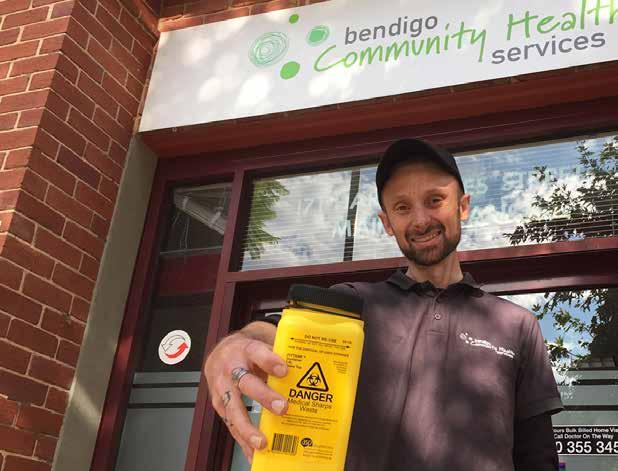
6 minute read
ICE USE IN THE COUNTRY: WORKERS SHARE THEIR EXPERIENCES

ICE USE IN THE COUNTRY: WORKERS SHARE THEIR EXPERIENCES IN NEW VIDEO SERIES
A new program developed by Penington Institute aims to educate workers in secondary NSPs and other health services to reduce the harms for clients who inject ice.
Injecting ice in the Country includes 10 videos and fact sheets that can be accessed from www.penington.org. au/injectingiceinthecountry. As well as building harm reduction capacity in rural and communities, the project aims to improve Aboriginal clients’ access to harm reduction services through both Aboriginal and mainstream services.
The Victorian Government funded the project after the Premier’s Ice Action Taskforce revealed that injecting ice was becoming an increasing concern in country areas. While targeted at rural and regional workers, the resources are relevant for anyone who has clients who inject ice. In the videos, NSP workers, doctors and other experts talk about key issues relating injecting ice, and how healthier approaches can be used to support clients to reduce the harms.
Topics include current trends in ice use, intoxication and withdrawal, psychological impacts, impacts on the body, safer injecting, harm reduction and engaging clients. Experts explain how ice can cause heart, liver and dental problems, and that NSP workers have vital roles in educating clients to reduce these harms. There are a range of risks that come with injecting ice that are unique; it can shrink veins, making it harder to inject, and along with tremor and blurred vision that clients experience, this can increase the risk of vein damage, missed hits and blood-borne virus transmission.
Ice use can make people feel invincible and lead to an increase in risk taking behaviours. It’s also associated with poor mental health, and often contributes to clients experiencing anxiety and depression. Bendigo Community Health Services Alcohol and Drug Community Senior Worker, Bart McGill, who is in the videos, says:
Bart McGill

“Variability and potency fluctuate wildly, and this can be a driver of harm for people who use ice. “It’s hard to gain knowledge about injecting; there’s no university or education class so these videos and factsheets are really helpful. “Secondary NSP workers have many competing priorities and can be unsupported in the critical work they do as NSP workers.” Bart says there are risks associated with injecting that are unique to ice and because it’s a stimulant, the body runs at an elevated rate which reduces appetite and the need for sleep. To access the resources, visit www.penington.org.au/ injectingiceinthecountry. Training sessions for staff can be booked by emailing info@penington.org.au.
- Helen Carter

TIPS FOR HELPING CLIENTS:
n Your approach is critical. It’s important to build trust with clients – this is made easier when they are confident that their information is confidential and won’t be shared with other staff or members of the community. n Be welcoming, approachable and respectful as clients treated respectfully are more likely initiate conversations with NSP staff.
n Building rapport takes time.
It’s important to be genuine, sincere and consistent. Being friendly and professional will reassure clients that you take their privacy and health concerns seriously. n Don’t be disheartened if clients are not talkative on all occasions; don’t expect or demand responses. n Building a relationship is vital as often the NSP worker is the only contact clients will have with a health service.
NSP workers who develop a relationship with the client may be able to open up a conversation about seeking further support. n Be patient; don’t ask too many questions as clients may not have slept or eaten for days – leaving them depleted and exhausted. n For Aboriginal clients cultural sensitivity and safety is important as trust in health services may be low. n Engaging Aboriginal clients is enhanced by understanding the cultural issues, including the impacts on family and community.
day and sleep at night to keep the body as close as possible to a natural routine and give it a chance to rest. n Avoid smoking and caffeine in the hours before injecting as they narrow veins. n Rotate injecting sites, practise good vein care, use sterile equipment and take more needles and syringes than you need, just in case.
TIPS FOR SAFER INJECTING:
n Hydration is critical so drink ample water. Amphetamines constrict veins, making injecting when dehydrated difficult, but keeping hydrated boosts liquid in veins, making it easier to inject safely. Being unable to access veins and jabbing repeatedly blunts needles, resulting in greater likelihood of vein damage. n Proper nutrition and sleep are vital to prevent bad outcomes. Inject during the
Injecting ice in the Country: factsheets
oaches INJECTING ICE IN THE COUNTRY Healthier Appr TING ICE INJEC COUNTRY IN THE
althier Approaches He
IN THE INJECTING ICE COUNTRY althier Approaches He INJECTING ICE IN THE C Healthier Appr
e an essential part of ound their effectiveness t for every one dollar spent alth care costs. e confidential and non-judgemental places where, in addition to obtaining sterile injecting equipment, clients can access: ted with injecting. educe the risk of blood and hepatitis C.
XICATION WAL ong and long-lasting stimulant. Needle and esent intoxicated on ted and may have difficulty ating. When clients come to the service while in e likely to be depleted, disoriented and How you engage with clients will depend on how they t any given time. While fects of ice are not the same for everyone, being familiar with the signs and symptoms of intoxication and e clients are at in their g.au/injectingiceinthecountry
HARM REDUCINJECTING AND TION omoting safer injecting messages and harm reduction supports each client and the wider community. Ice can be used in a number of ways – ingesting, snorting, smoking and injecting eople who are injecting face the highest risks. ficult to influence many of your clients’ behaviours, however your safer injecting practices can reduce injecting-related harms. tion about safe disposal of injecting equipment reduces omote to clients that they always take more equipment ends or during other periods when the service will not be in or to cover unplanned use by themselves or someone else. g.au/injectingiceinthecountry
e lik
ENGAGING CLIENTS WHO INJECT ICE Needle and Syringe Programs (NSPs) ar Australia’s health system. The evidence ar is well established – it is estimated tha on NSPs, four dollars are saved in direct he NSPs ar • Information on the health risks associa • Advice on safe injecting practices to r borne virus transmission including HIV Safe disposal advice and equipment. • Referral to other health and welfar• penington.or SAFER Your role in pr the health and wellbeing of – all of which have risks. P It may be dif reinforcement of Also, your communica overall risks for the community. It is important that you pr for nights, week operation, penington.or
ICE INTO AND WITHDRA Ice is a str Syringe Program (NSP) clients who pr ice will often be highly stimula concentr . withdrawal they ar in need of rest and recovery are feeling and what they need a the ef withdrawal will help you know wher cycle of use. penington.or WHAT IS ICE?In the Needle and Syringe Program (NSP), you’r come into contact with clients using ice in combina with other drugs. Drugs are classified according to how they affect the central nervous system (the network of nerve tissues that controls the activities of the body including the brain and spinal cord), and the related impact they have on mood and functioning. 15 penington.or






